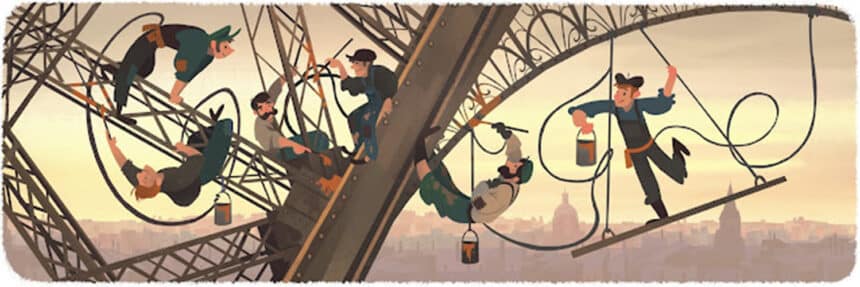Image Courtesy: Google Doodle
The Eiffel Tower is a famous landmark located in Paris, France. It was designed by Gustave Eiffel and built in 1889 as the entrance arch to the 1889 World’s Fair. The tower stands at 330 meters (1,083 feet) tall, about the same height as an 81-story building, and the tallest structure in Paris. Its base is square, measuring 125 meters (410 ft) on each side. During its construction, the Eiffel Tower surpassed the Washington Monument to become the tallest human-made structure in the world, a title it held for 41 years until the Chrysler Building in New York City was finished in 1930.
The tower is made of iron and has a distinctive lattice-like structure. It consists of four pillars that converge at the top to form a single point. Visitors can climb to the top of the tower using stairs or an elevator and enjoy panoramic views of Paris.
The tower has three levels for visitors, with restaurants on the first and second levels. The top level’s upper platform is 276 m (906 ft) above the ground – the highest observation deck accessible to the public in the European Union. Tickets can be purchased to ascend by stairs or lift to the first and second levels. The climb from ground level to the first level is over 300 steps, as is the climb from the first level to the second, making the entire ascent a 600-step climb. Although there is a staircase to the top level, it is usually accessible only by lift.
It is locally nicknamed “La dame de fer” (French for “Iron Lady”)
The Eiffel Tower has become a symbol of Paris and a popular tourist attraction. It has also been used for a variety of purposes over the years, including as a radio antenna and a scientific laboratory.
History of the Eiffel Tower
The Eiffel Tower was designed and built by Gustave Eiffel and his team of engineers for the 1889 World’s Fair held in Paris to commemorate the 100th anniversary of the French Revolution. Eiffel, a prominent French engineer and architect, was selected to design the tower after winning a competition organized by the French government.
Construction of the tower began on 28 January 1887 and was completed in just over two years. The tower was constructed using 18,000 iron pieces and over 2.5 million rivets. It was the tallest man-made structure at the time of its completion and held this record for 41 years until the Chrysler Building was built in New York City in 1930.
The Eiffel Tower in France was officially opened on 31 March 1889.
The Eiffel Tower was not immediately popular with the Parisian public, many of whom viewed it as an eyesore. However, it soon became an icon of modern architecture and a symbol of Paris, attracting millions of visitors every year.
During World War II, the Eiffel Tower played an important role as a communication center for the French resistance. In 1964, the tower was officially designated as a historic monument by the French government.
In order to celebrate the great architectural piece, on 31 March 2015, Google celebrated the 126th Anniversary of the public opening of the Eiffel Tower with a doodle.
Today, the Eiffel Tower remains one of the most popular tourist attractions in the world and a symbol of French culture and engineering ingenuity.
Significance of the Eiffel Tower
The Eiffel Tower is an iconic symbol of Paris and a cultural and architectural landmark of France. Its significance can be seen in several ways:
- Architectural significance: The tower’s design and engineering are considered a masterpiece of 19th-century engineering. The tower’s innovative design, including its unique lattice-like structure, has influenced the design of other buildings and structures around the world.
- Cultural significance: The tower has become a cultural icon and symbol of France, and is recognized worldwide as a symbol of romance, sophistication, and elegance. It attracts millions of visitors each year and is a popular destination for tourists from all over the world.
- Historical significance: The tower was built for the 1889 World’s Fair, which was held to celebrate the 100th anniversary of the French Revolution. The tower has witnessed many important events in French history, including serving as a communication center for the French Resistance during World War II.
- Economic significance: The Eiffel Tower is a major source of revenue for Paris and the French economy. It generates income through tourism, events, and merchandise sales.
Overall, the Eiffel Tower is a significant symbol of French culture, innovation, and engineering that has become an important landmark and tourist attraction for Paris and the world.

